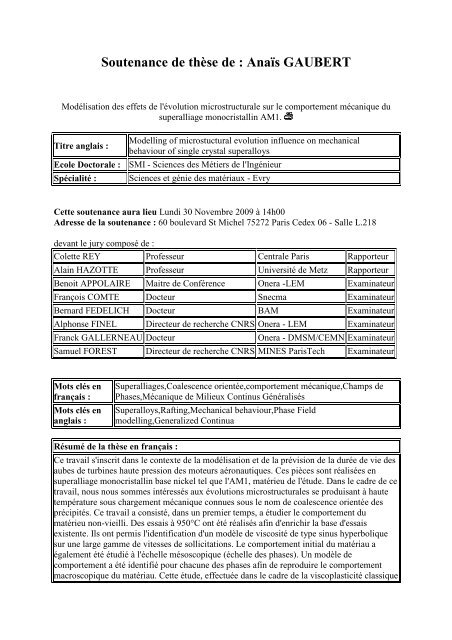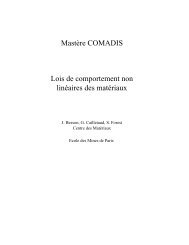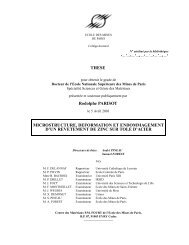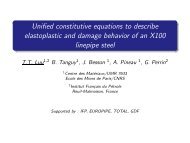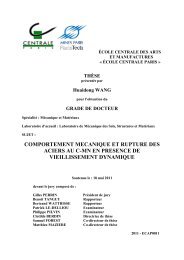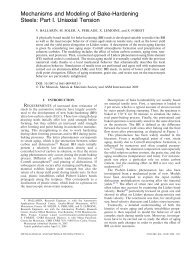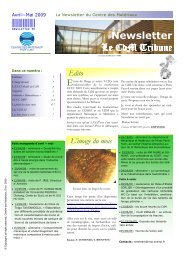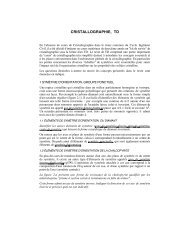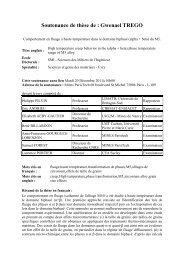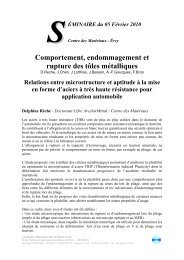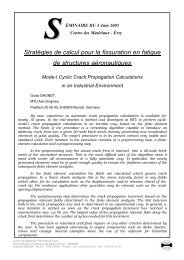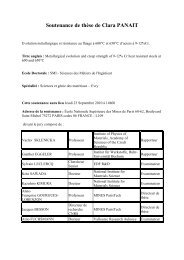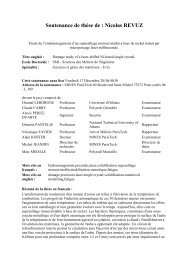Fiche de soutenance de Anais GAUBERT - MINES ParisTech
Fiche de soutenance de Anais GAUBERT - MINES ParisTech
Fiche de soutenance de Anais GAUBERT - MINES ParisTech
Create successful ePaper yourself
Turn your PDF publications into a flip-book with our unique Google optimized e-Paper software.
Soutenance <strong>de</strong> thèse <strong>de</strong> : Anaïs <strong>GAUBERT</strong>Modélisation <strong>de</strong>s effets <strong>de</strong> l'évolution microstructurale sur le comportement mécanique dusuperalliage monocristallin AM1.Titre anglais :Mo<strong>de</strong>lling of microstuctural evolution influence on mechanicalbehaviour of single crystal superalloysEcole Doctorale : SMI - Sciences <strong>de</strong>s Métiers <strong>de</strong> l'IngénieurSpécialité :Sciences et génie <strong>de</strong>s matériaux - EvryCette <strong>soutenance</strong> aura lieu Lundi 30 Novembre 2009 à 14h00Adresse <strong>de</strong> la <strong>soutenance</strong> : 60 boulevard St Michel 75272 Paris Ce<strong>de</strong>x 06 - Salle L.218<strong>de</strong>vant le jury composé <strong>de</strong> :Colette REY Professeur Centrale Paris RapporteurAlain HAZOTTE Professeur Université <strong>de</strong> Metz RapporteurBenoit APPOLAIRE Maitre <strong>de</strong> Conférence Onera -LEM ExaminateurFrançois COMTE Docteur Snecma ExaminateurBernard FEDELICH Docteur BAM ExaminateurAlphonse FINEL Directeur <strong>de</strong> recherche CNRS Onera - LEM ExaminateurFranck GALLERNEAU DocteurOnera - DMSM/CEMN ExaminateurSamuel FOREST Directeur <strong>de</strong> recherche CNRS <strong>MINES</strong> <strong>ParisTech</strong> ExaminateurMots clés enfrançais :Mots clés enanglais :Superalliages,Coalescence orientée,comportement mécanique,Champs <strong>de</strong>Phases,Mécanique <strong>de</strong> Milieux Continus GénéralisésSuperalloys,Rafting,Mechanical behaviour,Phase Fieldmo<strong>de</strong>lling,Generalized ContinuaRésumé <strong>de</strong> la thèse en français :Ce travail s'inscrit dans le contexte <strong>de</strong> la modélisation et <strong>de</strong> la prévision <strong>de</strong> la durée <strong>de</strong> vie <strong>de</strong>saubes <strong>de</strong> turbines haute pression <strong>de</strong>s moteurs aéronautiques. Ces pièces sont réalisées ensuperalliage monocristallin base nickel tel que l'AM1, matérieu <strong>de</strong> l'étu<strong>de</strong>. Dans le cadre <strong>de</strong> cetravail, nous nous sommes intéressés aux évolutions microstructurales se produisant à hautetempérature sous chargement mécanique connues sous le nom <strong>de</strong> coalescence orientée <strong>de</strong>sprécipités. Ce travail a consisté, dans un premier temps, a étudier le comportement dumatérieu non-vieilli. Des essais à 950°C ont été réalisés afin d'enrichir la base d'essaisexistente. Ils ont permis l'i<strong>de</strong>ntification d'un modèle <strong>de</strong> viscosité <strong>de</strong> type sinus hyperboliquesur une large gamme <strong>de</strong> vitesses <strong>de</strong> sollicitations. Le comportement initial du matériau aégalement été étudié à l'échelle mésoscopique (échelle <strong>de</strong>s phases). Un modèle <strong>de</strong>comportement a été i<strong>de</strong>ntifié pour chacune <strong>de</strong>s phases afin <strong>de</strong> reproduire le comportementmacroscopique du matériau. Cette étu<strong>de</strong>, effectuée dans le cadre <strong>de</strong> la viscoplasticité classique
a permis <strong>de</strong> mettre en évi<strong>de</strong>nce les limites <strong>de</strong> cette approche. Notamment, elle ne permet pas<strong>de</strong> modéliser les effets d'échelle observés en plasticité. Parallèlement, nous nous sommesintéressés au phénomène <strong>de</strong> coalescence orientée, tant d'un point <strong>de</strong> vue expérimental quenumérique. Des essais mécaniques après vieillissement ont été réalisés. Différentes conditions<strong>de</strong> vieillissement ont été étudiées, en fluage à différentes température et contraintes et suivantdifférentes orientations cristallographiques mais également sous chargement cyclique. Lesessais mécaniques ont montré un effet prépondérant <strong>de</strong> la coalescence orientée surl'écrouissage du matériau, allant dans le sens d'un adoucissement. La coalescence orientée aégalement été modélisée par la métho<strong>de</strong> <strong>de</strong>s champs <strong>de</strong> phases. Nous avons proposé uncouplage du modèle champs <strong>de</strong> phases avec un modèle <strong>de</strong> comportement <strong>de</strong> viscoplasticitécristalline afin <strong>de</strong> prendre en compte l'influence <strong>de</strong> l'activité plastique dans les couloirs <strong>de</strong>matrice. Les simulations ont montré une accélération <strong>de</strong> la cinétique <strong>de</strong> mise en ra<strong>de</strong>aux due àla plasticité ainsi que <strong>de</strong>s précipités ayant une forme plus réaliste vis-à-vis <strong>de</strong> l'expérience,notamment en vieillissement sous chargement cyclique lent. La prise en compte <strong>de</strong>s effets <strong>de</strong>la coalescence orientée passe par la modélisation <strong>de</strong>s effets d'échelle en plasticité. C'estpourquoi nous nous sommes intéressés aux milieux continus généralisés. Nous avons étudiéanalytiquement les effets d'échelle produits par un modèle <strong>de</strong> Cosserat et le modèle microcurldans le cas d'un matériau biphasé en cisaillement. Les <strong>de</strong>ux modèles prévoient un écrouissagecinématique linéaire dépendant <strong>de</strong> la taille <strong>de</strong> la microstructure. Enfin, les développementprécé<strong>de</strong>nts et les essais réalisés dans le cadre <strong>de</strong> ce travail ont permis la construction etl'i<strong>de</strong>ntification d'un modèle macroscopique étendu qui rend compte <strong>de</strong>s effets <strong>de</strong> lacoalescence orientée sur le comportement mécanique <strong>de</strong> l'AM1.Résumé <strong>de</strong> la thèse en anglais:The framework of this thesis is the mo<strong>de</strong>lling and the lifetime prediction of high pressureaeronautical turbine bla<strong>de</strong>s. These parts are realized in nickel base single crystal superalloys.This work is focused on the microstructural evolution arising at high temperatures un<strong>de</strong>rmechanical loading known as the directionnal coarsening. In a first time, this work consists instudying the mechanical behaviour of the initial non-aged material. Tests have beenperformed at 950°C in or<strong>de</strong>r to enrich the available data base. They have allowed us toi<strong>de</strong>ntify a hyperbolic sinus viscosity mo<strong>de</strong>l over a wi<strong>de</strong> range of stain rates. The initialbehaviour has also been studied at the mesoscopic scale. A constitutive mo<strong>de</strong>l has beeni<strong>de</strong>ntified for both phases in or<strong>de</strong>r to reproduce the macroscopic behaviour of the material.This study, performed in the classical viscoplasticity framework, shows the limits of thisapproach. In particular, it does not allow to mo<strong>de</strong>l the length scale effects observed inplasticity. In the same time, we have studied the directionnal coarsening phenomenon in bothexperimental and numeric ways. Mechanical test after ageing have been realized. Variousageing conditions have been tested, in creep at different temperatures and stresses and alongdifferent cristallographic orientations but also un<strong>de</strong>r cyclic loading. Tests have shown aneffect of the directionnal coarsening on the har<strong>de</strong>ning. More precisely, the directionnalcorasening induces a softening of the material behaviour. Directionnal coarsening has alsobeen simulated with the phase field method. We have proposed a coupling between the phasefield mo<strong>de</strong>l and a viscoplastic crystal plasticity mo<strong>de</strong>l in or<strong>de</strong>r to take into account theplasticity in the evolving matrix channels. Simulations have shown an increase in the kineticsof the rafting evolution induced by plasticity and a more realistic morphology of theprecipitates as observed axperimentally, in particular un<strong>de</strong>r cyclic ageing. In or<strong>de</strong>r toun<strong>de</strong>rstand the influence of the directionnal coarsening on the mechanical behaviour, lengthscale effects were analyzed in the framework of generalized continuum approaches like theCosserat and the microcurl mo<strong>de</strong>ls. In or<strong>de</strong>r to compare the results obtained with both
approaches, a two--phase laminate loa<strong>de</strong>d in shear has been studied analytically. Both mo<strong>de</strong>ls<strong>de</strong>liver a linear kinematic har<strong>de</strong>ning <strong>de</strong>pendant on the size of the microstructure. Finally, theprevious <strong>de</strong>velopement and the tests performed during this work allow to propose and i<strong>de</strong>ntifyan exten<strong>de</strong>d macroscopic mo<strong>de</strong>l which takes into account the effects of the directionnalcoarsening on the machanical behaviour of the AM1 superalloy.


